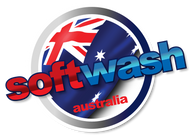Introduction to Softwash Cleaning
Soft washing is a cleaning method that utilises low-pressure washing techniques. Effective treatment requires a combination of cleaning surfactants, sanitiser, and water to gently clean exterior surfaces of organic growths and staining. Soft washing is a gentler and often more efficient process for exterior cleaning purposes.
What is a Softwashing System?
A softwashing system is a dedicated pump system capable of applying a sanitizing soap solution to building exteriors, roofs, facades etc. The Soft Washing method is combined with a biodegradable disinfecting cleaning solution to break down and kill the mildew, mold, moss, bacteria, algae, fungus, etc. These systems can be basic batch style systems or more evolved with blending manifolds for chemical control and rinse mechanisms. Softwash Australia’s 150L batch system is a great example of a more rudimentary system.
Our low-only and high/low systems are an example of the latter.
The Benefits of Softwashing
Softwashing is a fast and efficient method of exterior cleaning. Softwashing’s high-volume, low-pressure approach means a gentler and more careful clean is applied to the substrate or surface. The ability to broadcast cleaning solutions across a large area quickly, at height, means that surfaces can be cleaned from the ground that previously would require the intervention of lift equipment.
Softwashing vs. Power/Pressure Washing
To the untrained eye, soft washing and pressure washing appear similar. Anyone in the industry would know that in fact, they require different techniques, equipment, pressure and chemicals.
As previously stated, soft washing is a process of low-pressure, high-volume application. Whereby a solution is generated to suit the requirements of the surface, applied, and then simply rinsed away. Pressure washing is a low-volume, high pressure process whereby the offending stains are mechanically etched off the surface with high-forced water.
Effectiveness / Costs
With soft washing, the offending stains are not only removed, but sanitised. Therefore, there is a longer lasting clean. This means that the intervals between cleaning can be fewer and farther, saving you time and money in the grand scheme. This is why there has been a growing trend for customers and cleaners alike to opt for the soft washing methodology.
While softwashing is generally the gentler method and more aimed at structural cleaning, pressure washing continues to have a significant place in the industry as the go-to process for hard surface cleaning. Fleet washing, gum and graffiti removal, grease and oil stain removal and pre-paint preparation are just some of the applications in which this method can be used.
Either method comes with its strengths and limitations when considering application and cost, it is therefore up to the cleaning professional to know which to use and why.
Ideal Applications of Softwash Cleaning
The ideal applications of softwashing are:
- House wash;
- Building wash down;
- Roof cleaning;
- Canvas/shade-sails/awnings;
- Water towers/silos;
- Playground equipment
The Science Behind Softwash Cleaning
We pride ourselves on our understanding of the science behind the process of soft washing.
Generating the correct solution for softwash cleaning will be determined by the offending staining on the surface to be cleaned. More often than not, these stains will be organic growth systems such as mold, algae, mildew and lichen.
Choosing sodium hypochlorite as the predominant sanitiser allows for the instantaneous corrosion of those simple organic systems on application. The combination of surfactant and other environmental cleaners, such as EBC multi-purpose cleaner, allows the solution to affect the staining in several ways.
- The sodium hypochlorite will effectively corrode and break down the molecular structure of the organic element (mold, mildew etc.)
- The surfactant will act as a wetting agent and carry this sanitising solution deep into the surface. It will also change the relationship between the offending stain and the hold that it has on the substrate.
- The introduction of environmental cleaner (EBC) will see the combination of cleaning surfactants affect non-organic elements of the staining and act as a genuine cleaner.
- Introducing the final element, water. A volume rinse will cede the benefits of a quality surfactant where the now decayed growth/staining will wish to simply slide off the surface. A generous rinse will also further dilute the initial solution, to a PH neutral state.





